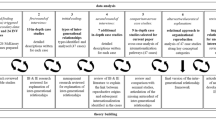Abstract
This paper identifies how dialectical tensions influence the conflicts in and unplanned terminations of international joint venture (IJV) relationships. The findings from case studies of two Finnish-Chinese JVs show how initial tensions and institutional imprints set the IJV processes in motion; how critical junctures influence perception of the IJV relationship and its evolution; and how a lack of efficient communication, interlinks between dialectical tensions, and insufficient movement of trust between cultural, organizational, and individual levels in the relationship lock in action patterns of confrontation which lead to the termination of the IJV. In essence, this study contributes to international business research by explaining the path-dependent nature of dialectical tensions in the evolution and survival of cross-cultural JVs.



Similar content being viewed by others
References
Adler, N. J., Campbell, N., & Laurent, A. 1989. In search of appropriate methodology: From outside the People’s Republic of China looking in. Journal of International Business Studies, 20(1): 62–74.
Ariño, A., & Torre, J. 1998. Learning from failure: Towards an evolutionary model of collaborative ventures. Organization Science, 9(3): 306–325.
Arthur, W. B. 1994. Increasing returns and path dependence in the economy. Ann Arbor, MI: University of Michigan Press.
Barkema, H. G., & Vermeulen, F. 1997. What differences in the cultural background of partners are detrimental for international joint ventures?. Journal of International Business Studies, 28(4): 845–864.
Benson, J. K. 1977. Organizations: A dialectical view. Administrative Science Quarterly, 22(1): 1–21.
Bergson, H. 1946. The creative mind. New York: Carol Publishing Group.
Buck, T., Liu, X., & Ott, U. 2010. Long-term orientation and international joint venture strategies in modern China. International Business Review, 19: 223–234.
Büchel, B. 2002. Joint venture development: Driving forces towards equilibrium. Journal of World Business, 37: 199–207.
Büthe, T. 2002. Taking temporality seriously: Modelling history and the use of narratives as evidence. American Political Science Review, 96(3): 481–492.
Chen, X., & Chen, C. C. 2004. On the intricacies of the Chinese guanxi: A process model of guanxi development. Asia Pacific Journal of Management, 21(3): 305–324.
Choi, C.-B., & Beamish, P. W. 2011. Resource complementarity and international joint venture performance in Korea. Asia Pacific Journal of Management. doi:10.1007/s10490-011-9258-4.
Crouch, C., & Farrell, H. 2004. Breaking the path of institutional development? Alternatives to the new determinism. Rationality and Society, 16(1): 5–43.
Currall, S. C., & Inkpen, A. C. 2002. A multilevel approach to trust in joint ventures. Journal of International Business Studies, 33(3): 479–495.
Damanpour, F., Devece, C., Chen, C. C., & Pothukuchi, V. 2011. Organizational culture and partner interaction in the management of international joint ventures in India. Asia Pacific Journal of Management. doi:10.1007/s10490-010-9204-x.
Das, T. K., & Teng, B. 1998. Between trust and control: Developing confidence in partner cooperation in alliances. Academy of Management Review, 23(3): 491–512.
Das, T. K., & Teng, B. 2000. Instabilities of strategic alliances: An internal tensions perspective. Organization Science, 11(1): 77–101.
David, P. 1986. Understanding the economics of QWERTY: The necessity of history. In W. Parker (Ed.). Economic history and the modern economist: 30–49. New York: Basil Blackwell.
de Rond, M., & Bouchikhi, H. 2004. On the dialectics of strategic alliances. Organization Science, 15(1): 56–69.
Doz, Y. L. 1996. The evolution of cooperation in strategic alliances: Initial conditions or learning processes?. Strategic Management Journal, 17(Special Issue): 55–83.
Doz, Y. L., Olk, P. M., & Ring, P. S. 2000. Formation processes of R&D consortia: Which path to take? Where does it lead?. Strategic Management Journal, 21(Special Issue): 239–266.
Eisenhardt, K. M., & Graebner, M. E. 2007. Theory building from cases: Opportunities and challenges. Academy of Management Journal, 50(1): 25–32.
Faure, G. O., & Fang, T. 2008. Changing Chinese values: Keeping up with paradoxes. International Business Review, 17: 194–207.
Ganesan, S. 1994. Determinants of long-term orientation in buyer-seller relationships. Journal of Marketing, 58(2): 1–19.
Garud, R., & Karnøe, P. 2001. Path creation as a process of mindful deviation. In R. Garud & P. Karnøe (Eds.). Path dependence and path creation. Mahwah, NJ: Lawrence Earlbaum.
George, A. L., & Bennett, A. 2005. Case studies and theory development in the social sciences. Cambridge: MIT Press.
Geringer, J. M., & Hebert, L. 1989. Control and performance of international joint ventures. Journal of International Business Studies, 20(2): 235–254.
Glaister, K. W., & Buckley, P. J. 1996. Strategic motives for international alliance formation. Journal of Management Studies, 33(3): 301–332.
Hamel, G. 1991. Competition for competence and inter-partner learning within international strategic alliances. Strategic Management Journal, 12(Summer): 83–103.
Hofstede, G. 1997. Cultures and organizations: Software of the mind. New York: McGraw Hill.
Inkpen, A. C., & Beamish, P. W. 1997. Knowledge, bargaining power, and the instability of international joint ventures. Academy of Management Review, 22(1): 177–202.
Inkpen, A. C., & Currall, S. C. 2004. The coevolution of trust, control and learning in joint ventures. Organization Science, 15(5): 586–599.
Koch, B. J., & Koch, P. T. 2007. Collectivism, individualism, and outgroup cooperation in a segmented China. Asia Pacific Journal of Management, 24(2): 207–225.
Kogut, B. 1988. Joint ventures: Theoretical and empirical perspectives. Strategic Management Journal, 9(4): 319–332.
Kwon, J.-W. 2011. Does China have more than one culture? Exploring regional differences of work values in China. Asia Pacific Journal of Management. doi:10.1007/s10490-010-9191-y.
Lamberg, J. A., & Pajunen, K. 2010. Agency, institutional change, and continuity: The case of the Finnish Civil War. Journal of Management Studies, 47(5): 814–836.
Lamberg, J. A., Pajunen, K., Parvinen, P., & Savage, G. T. 2008. Stakeholder management and path dependence in organizational transitions. Management Decision, 46(6): 846–863.
Leonard-Barton, D. 1990. A dual methodology for case studies: Synergistic use of a longitudinal single site with replicated multiple sites. Organization Science, 1(3): 248–266.
Leung, K. 2008. Chinese culture, modernization, and international business. International Business Review, 17: 184–187.
Lewicki, R. J., McAllister, D. J., & Bies, R. J. 1998. Trust and distrust: New relationships and realities. Academy of Management Review, 23(3): 438–458.
Luo, Y. 1997. Partner selection and venturing success: The case of joint ventures with firms in the People’s Republic of China. Organization Science, 8(6): 648–662.
Luo, Y. 2002. Stimulating exchange in international joint ventures: An attachment-based view. Journal of International Business Studies, 33(1): 169–181.
Luo, Y., & Chen, M. 1997. Does guanxi influence firm performance?. Asia Pacific Journal of Management, 14(1): 1–16.
Luo, Y., & Park, S. H. 2004. Multiparty cooperation and performance in international equity joint ventures. Journal of International Business Studies, 35(2): 142–160.
Luo, Y., Shenkar, O., & Gurnani, H. 2008. Control-cooperation interfaces in global strategic alliances: A situational typology and strategic responses. Journal of International Business Studies, 39(3): 428–453.
Madhok, A. 1995. Revisiting multinational firms’ tolerance for joint ventures: A trust-based approach. Journal of International Business Studies, 26(1): 117–137.
Mahoney, J. 2000. Path dependence in historical sociology. Theory and Society, 29(4): 507–547.
Mahoney, J. 2001. Path-dependent explanations of regime change: Central America in comparative perspective. Studies in Comparative International Development, 36(1): 111–141.
Makino, S., Chan, C. M., Isobe, T., & Beamish, P. W. 2007. Intended and unintended termination of international joint ventures. Strategic Management Journal, 28: 1113–1132.
Miles, M. B., & Huberman, A. M. 1994. Qualitative data analysis. London: Sage.
MOFCOM. 2008. Investment statistics. Beijing: Ministry of Commerce and of the People’s Republic of China.
Nonaka, I. 1994. Dynamic theory of organizational knowledge creation. Organization Science, 5(1): 14–37.
Oyserman, D., Coon, H. M., & Kemmelmeier, M. 2002. Rethinking individualism and collectivism: Evaluation of theoretical assumptions and meta-analyses. Psychological Bulletin, 128(1): 3–72.
Page, S. E. 2006. Path dependence. Quarterly Journal of Political Science, 1: 87–115.
Pajunen, K. 2008. The nature of organizational mechanisms. Organization Studies, 29(11): 1449–1468.
Park, S. H., & Luo, Y. 2001. Guanxi and organizational dynamics: Organizational networking in Chinese firms. Strategic Management Journal, 22(5): 455–477.
Parkhe, A. 1993. “Messy” research, methodological predispositions, and theory development in international joint ventures. Academy of Management Review, 18(2): 227–268.
Peng, K., & Nisbett, R. E. 1999. Culture, dialectics, and reasoning about contradiction. American Psychologist, 54(9): 741–754.
Peng, M. W., & Heath, P. S. 1996. The growth of the firm in planned economies in transition: Institutions, organizations and strategic choice. Academy of Management Review, 21(2): 492–528.
Pentland, B. T. 1999. Building process theory with narrative: From description to explanation. Academy of Management Review, 24(4): 711–724.
Pierson, P. 2000. Increasing returns, path dependence, and the study of politics. American Political Science Review, 94(2): 251–267.
Prahalad, C. K., & Bettis, R. A. 1986. The dominant logic: A new linkage between diversity and performance. Strategic Management Journal, 7: 485–501.
Puck, J. F., Holtbrügge, D., & Mohr, A. T. 2009. Beyond entry mode choice: Explaining the conversion of joint ventures into wholly owned subsidiaries in the People’s Republic of China. Journal of International Business Studies, 40(3): 388–404.
Ralston, D. A., Egri, C. P., Stewart, S., Terpstra, R. H., & Yu, K. 1999. Doing business in the 21st century with the new generation of Chinese manager: A study of generational shifts in work values in China. Journal of International Business Studies, 30(3): 415–428.
Reus, T. H., & Rottig, D. 2009. Meta-analyses of international joint venture performance determinants: Evidence for theory, methodological artifacts and the unique context of China. Management International Review, 49: 607–640.
Salk, J. E. 2005. Often called for but rarely chosen: Alliance research that directly studies processes. European Management Review, 2(2): 117–122.
Salk, J. E., & Shenkar, O. 2001. Social identities in an international joint venture: An exploratory case study. Organization Science, 12(2): 161–178.
Schreyögg, G., & Sydow, J. 2011. Organizational path dependence: A process view. Organization Studies, 32(3): 321–335.
Schwartz, S. H. 1990. Individualism-collectivism: Critique and proposed refinements. Journal of Cross-Cultural Psychology, 21(2): 139–157.
Seabright, M. A., Levinthal, D. A., & Fichman, M. 1992. Role of individual attachments in the dissolution of interorganizational relationships. Academy of Management Journal, 35(1): 122–160.
Shenkar, O., & Yan, A. 2002. Failure as a consequence of partner politics: Learning from the life and death of an international cooperative venture. Human Relations, 55(5): 565–601.
Staw, B. M., Sandelands, L. E., & Dutton, J. E. 1981. Threat-rigidity effects in organizational behavior: A multilevel analysis. Administrative Science Quarterly, 26(4): 501–524.
Steensma, H. K., Barden, J. Q., Dhanaraj, C., Lyles, M., & Tihanyi, L. 2008. The evolution and internalization of international joint ventures in a transitioning economy. Journal of International Business Studies, 39(3): 491–507.
Sydow, J., Schreyögg, G., & Koch, J. 2009. Organizational path dependence: Opening the black box. Academy of Management Review, 34(4): 689–709.
Tsoukas, H., & Chia, R. 2002. On organizational becoming: Rethinking organizational change. Organization Science, 13(5): 567–582.
Tung, R. L. 2008. The cross-cultural research imperative: The need to balance cross-national and intra-national diversity. Journal of International Business Studies, 39(1): 41–46.
Van de Ven, A. H., & Poole, M. S. 1995. Explaining development and change in organizations. Academy of Management Review, 20(3): 510–540.
Xin, K., & Pearce, J. L. 1996. Guanxi: Connections as substitutes for formal institutional support. Academy of Management Journal, 39(6): 1641–1658.
Yan, A., & Zeng, M. 1999. International joint venture instability: A critique of previous research, a reconceptualization, and directions for future research. Journal of International Business Studies, 30(2): 397–414.
Yeung, I. Y. M., & Tung, R. L. 1996. guanxi (connections). Organizational Dynamics, Autumn: 54–65.
Author information
Authors and Affiliations
Corresponding author
Additional information
The constructive comments of Senior Editor Klaus E. Meyer and anonymous reviewers greatly helped to improve this paper. The support of Timo Lasola and members of GloStra research group are also acknowledged.
Rights and permissions
About this article
Cite this article
Pajunen, K., Fang, L. Dialectical tensions and path dependence in international joint venture evolution and termination. Asia Pac J Manag 30, 577–600 (2013). https://doi.org/10.1007/s10490-011-9267-3
Published:
Issue Date:
DOI: https://doi.org/10.1007/s10490-011-9267-3




